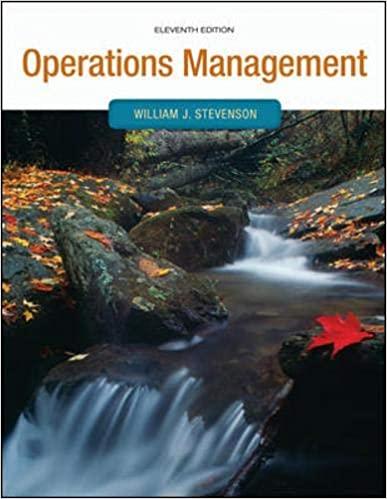Answered step by step
Verified Expert Solution
Question
1 Approved Answer
Case 7 Please be as elaborate as possible, this is a Strategic Management university paper. Please give a complete analysis of the case. Identify the
Case 7
Please be as elaborate as possible, this is a Strategic Management university paper.
Please give a complete analysis of the case. Identify the problems and give solutions. Give a complete SWOT and PESTEL analysis of the Case study (SWOT and PESTEL). What is their competitive advantage over the market? What are your recommendations?
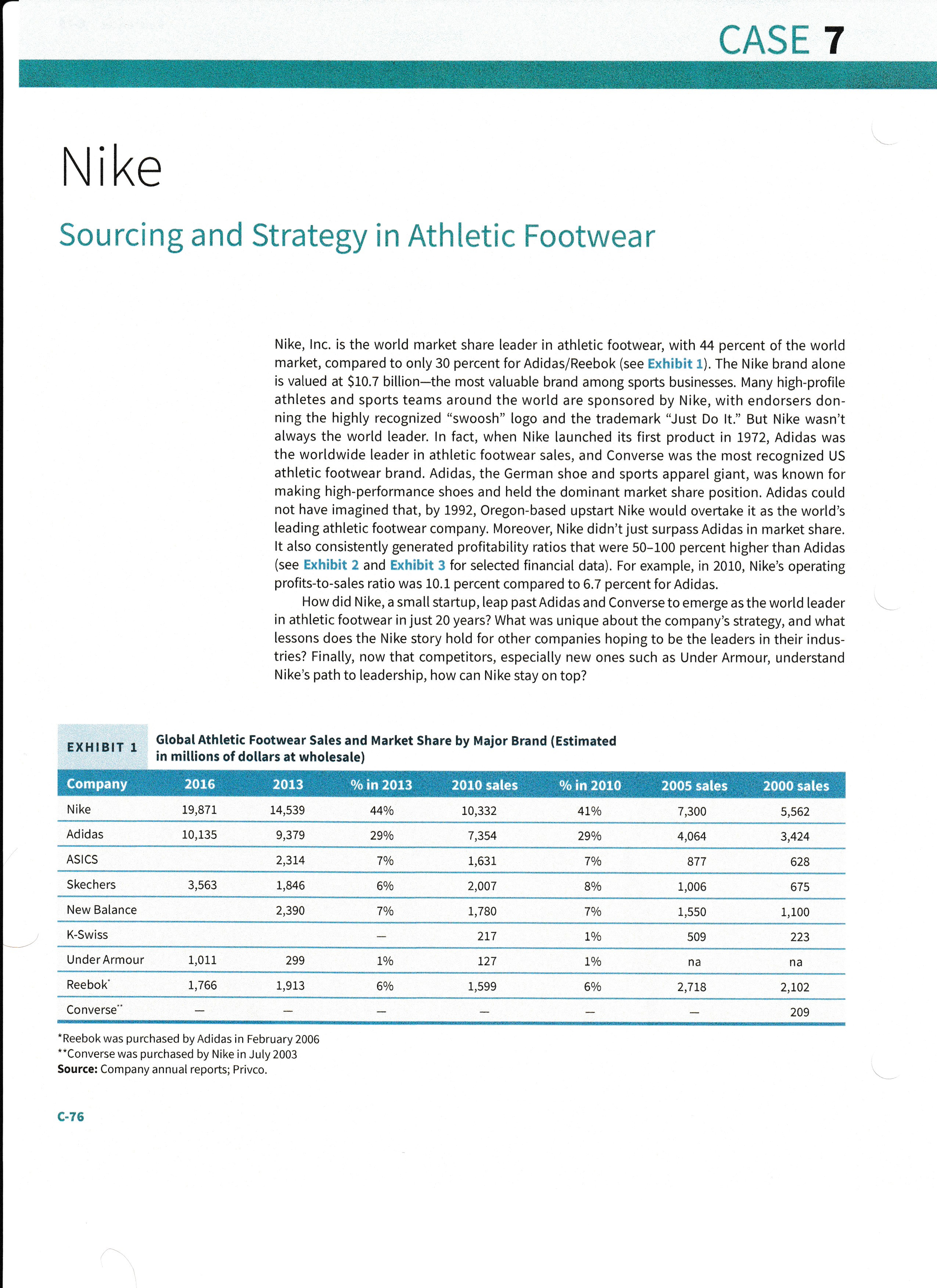
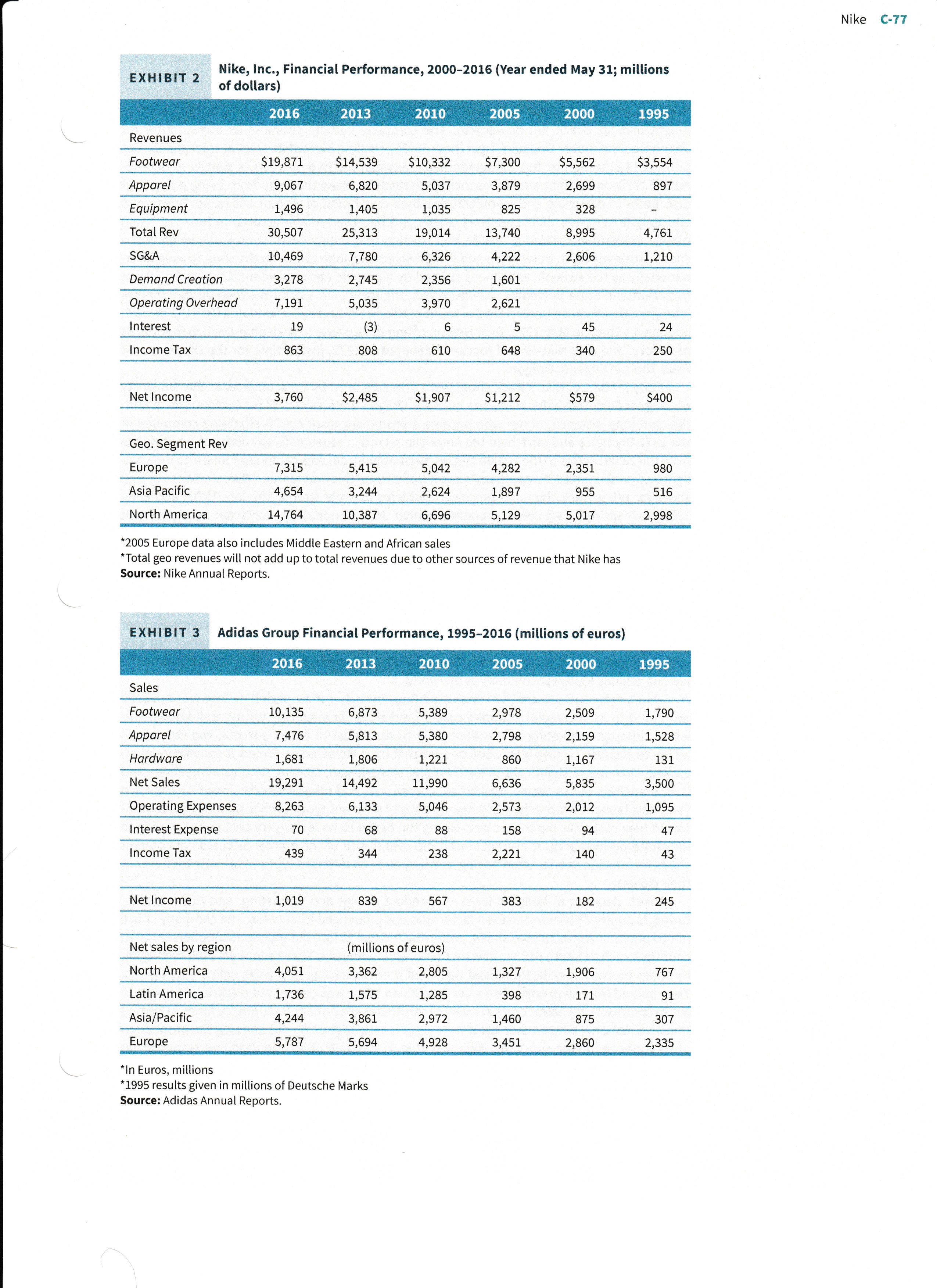
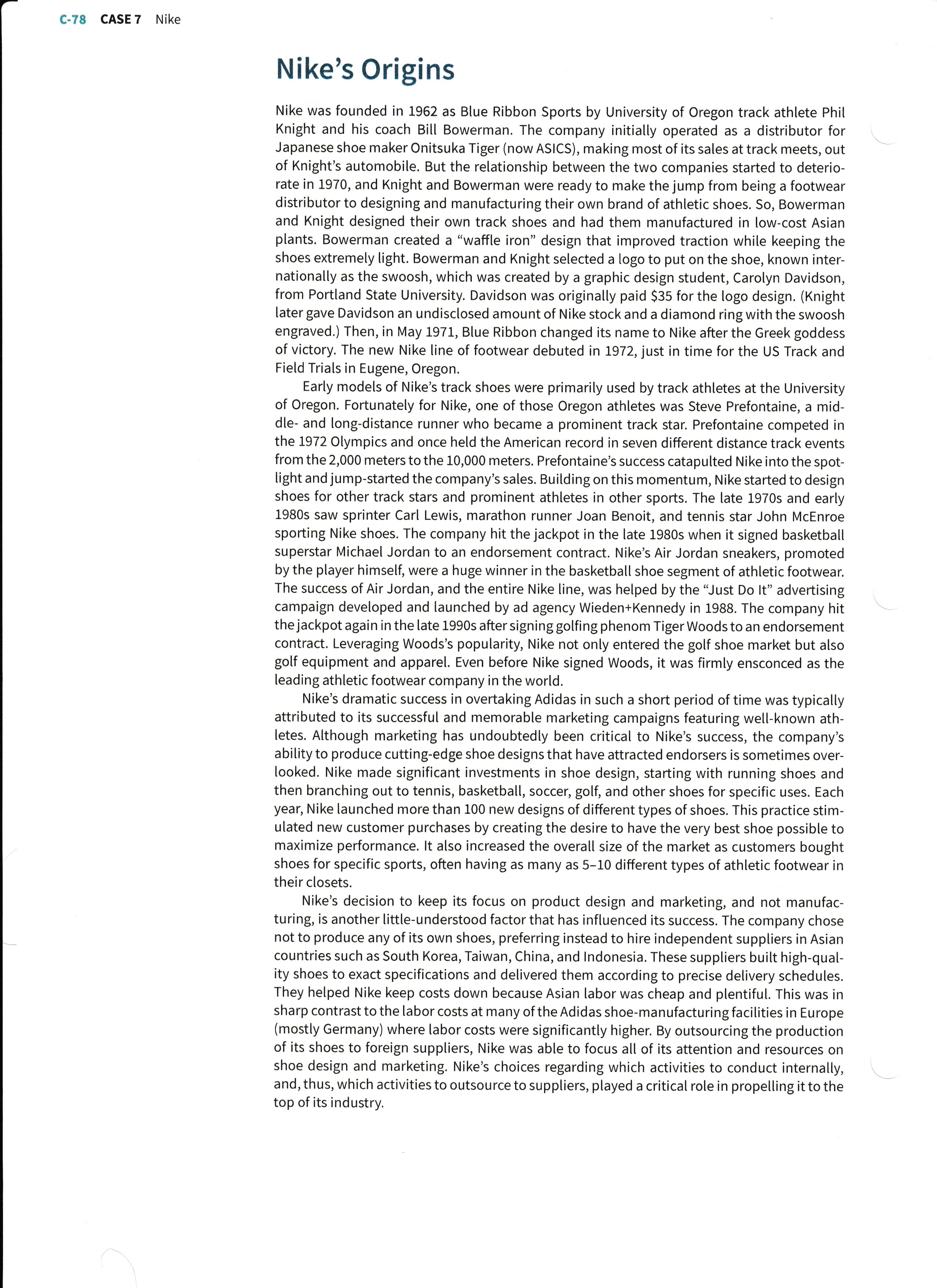
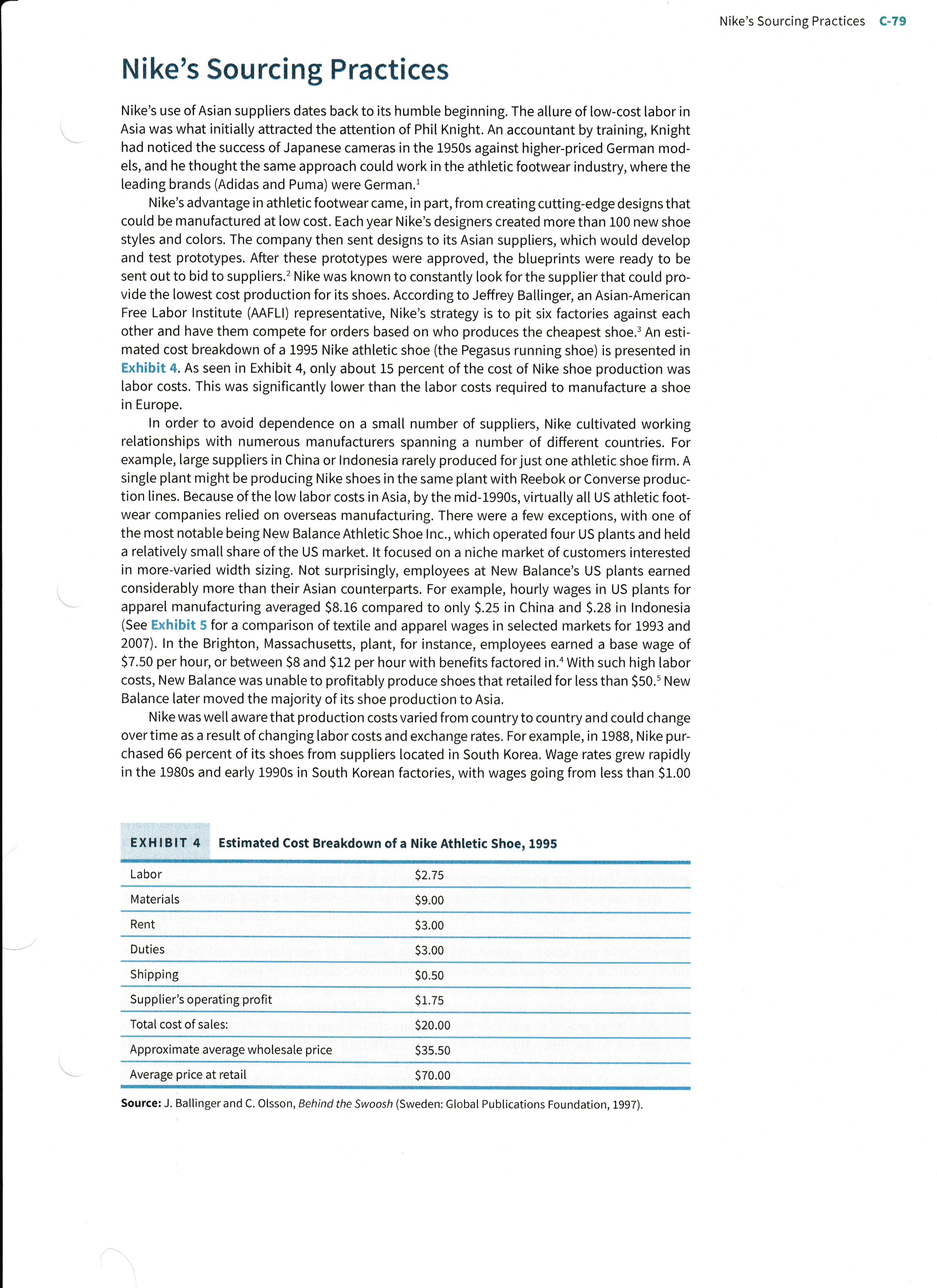
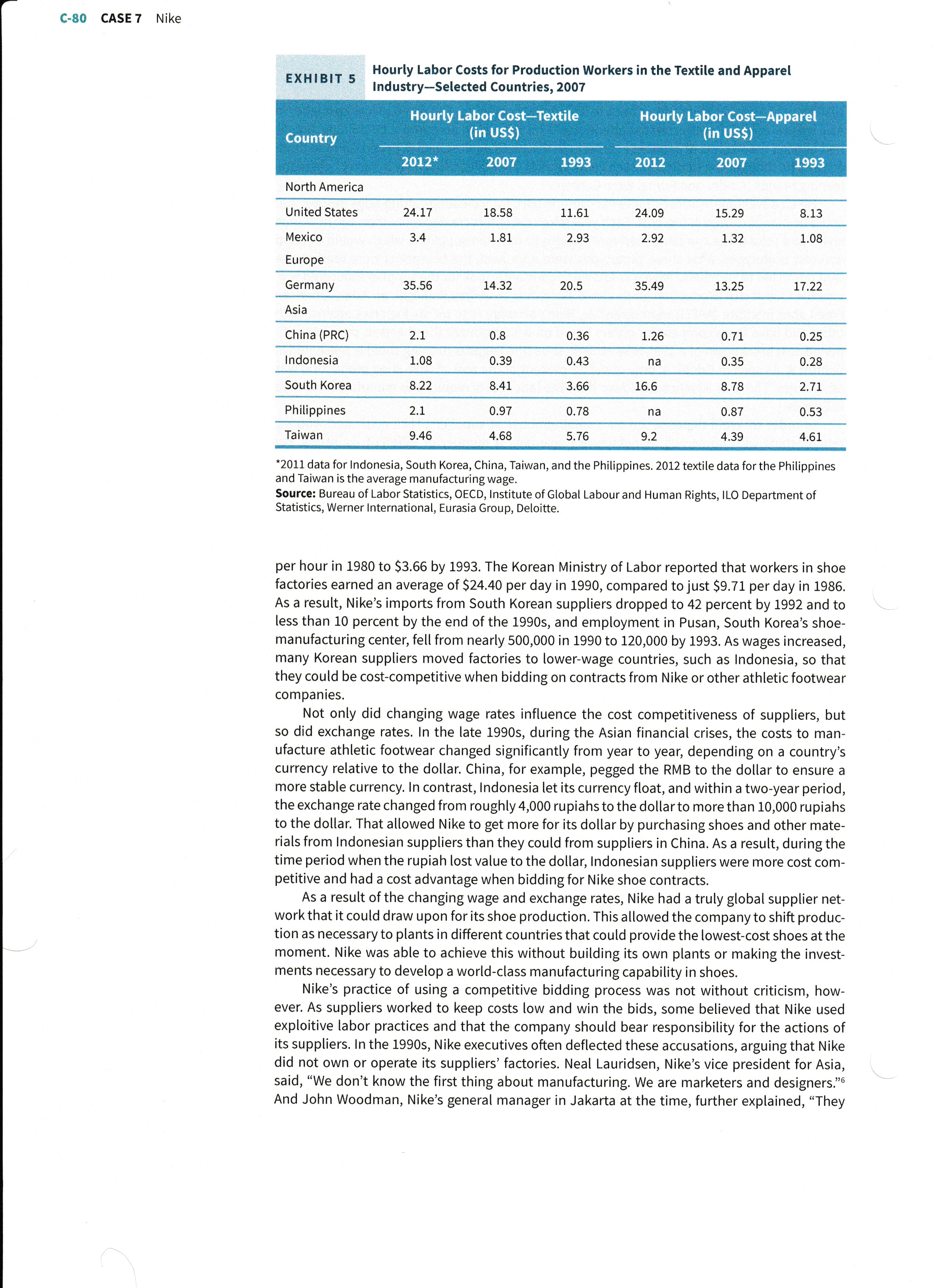
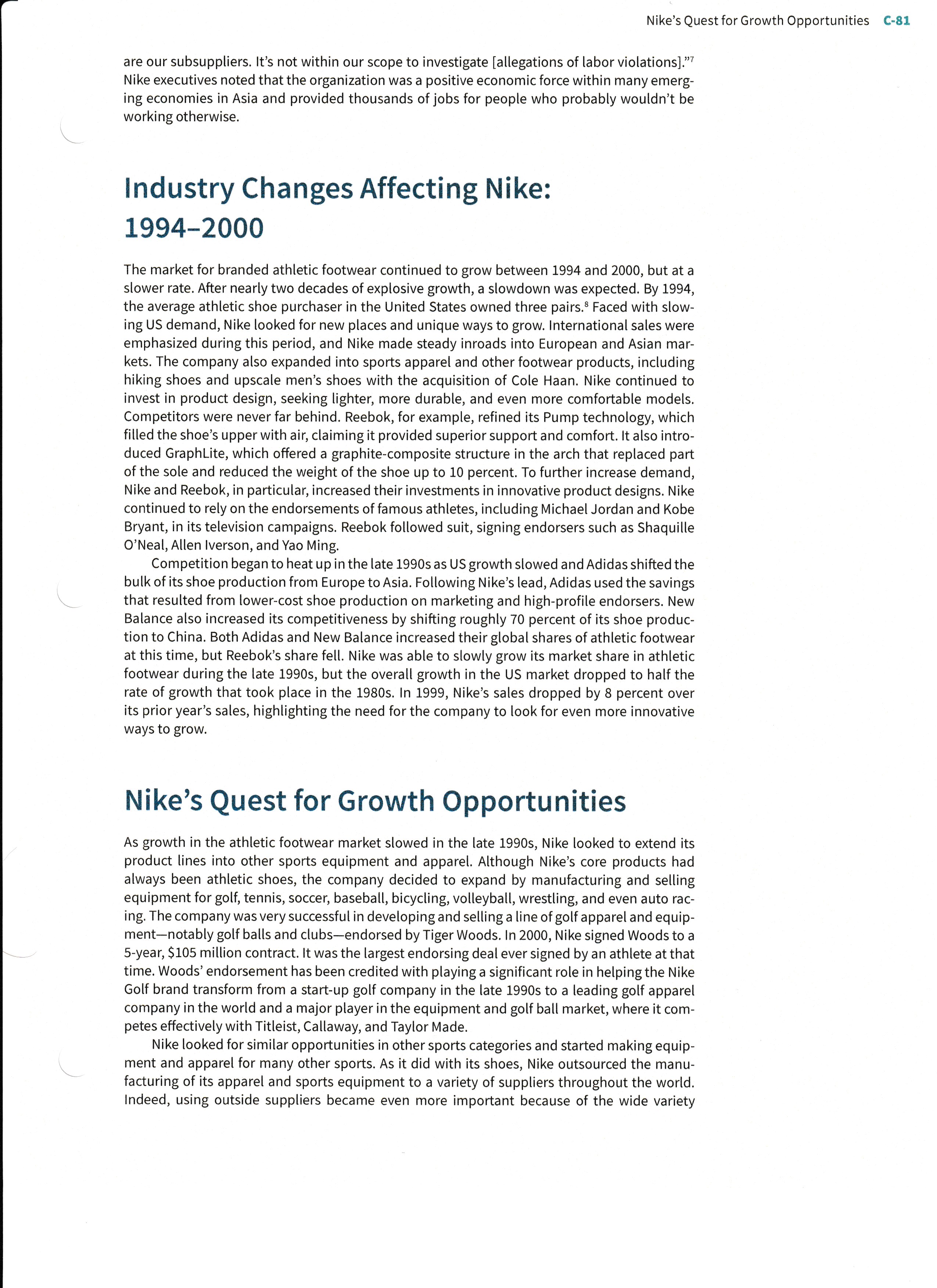
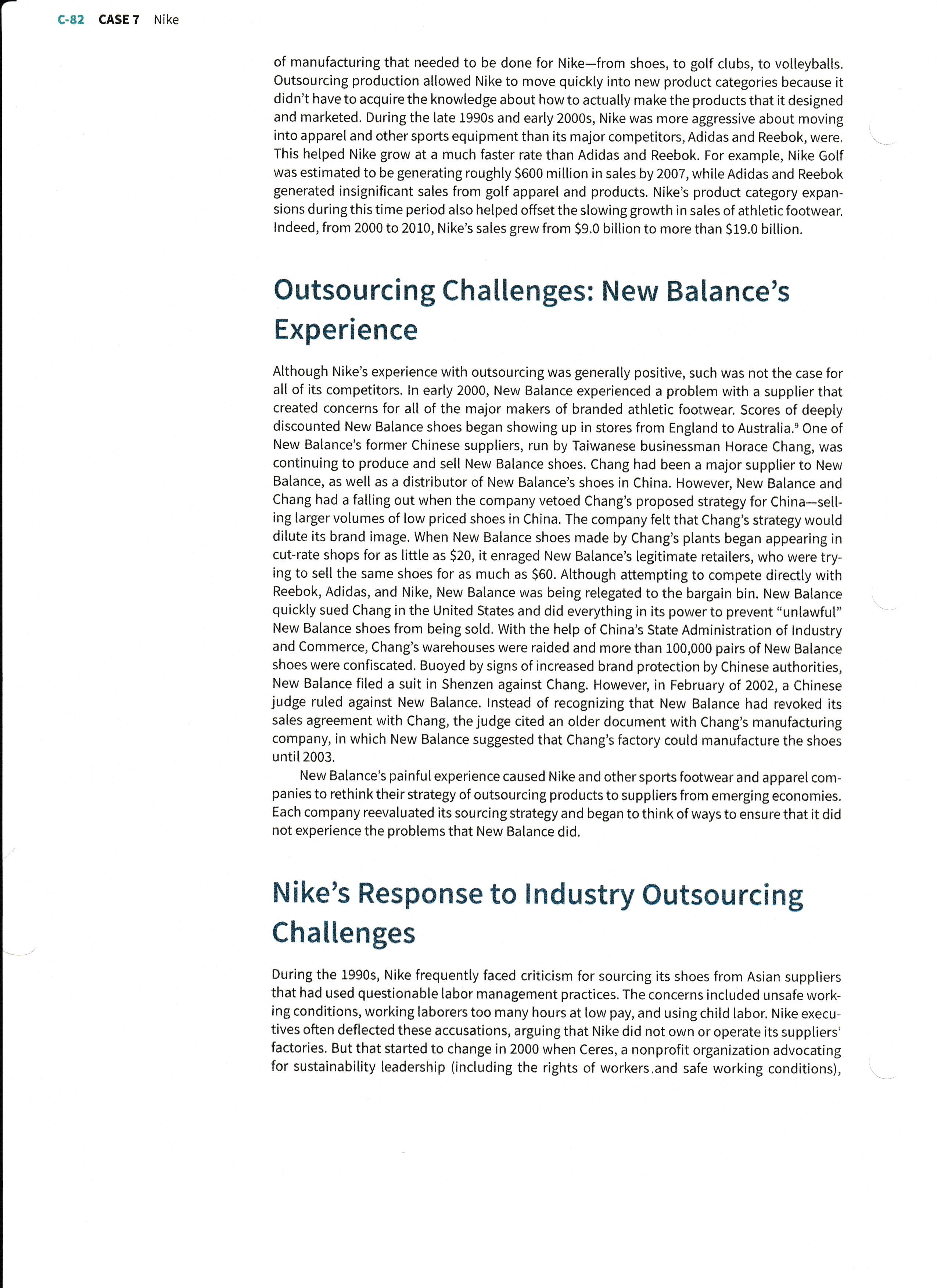
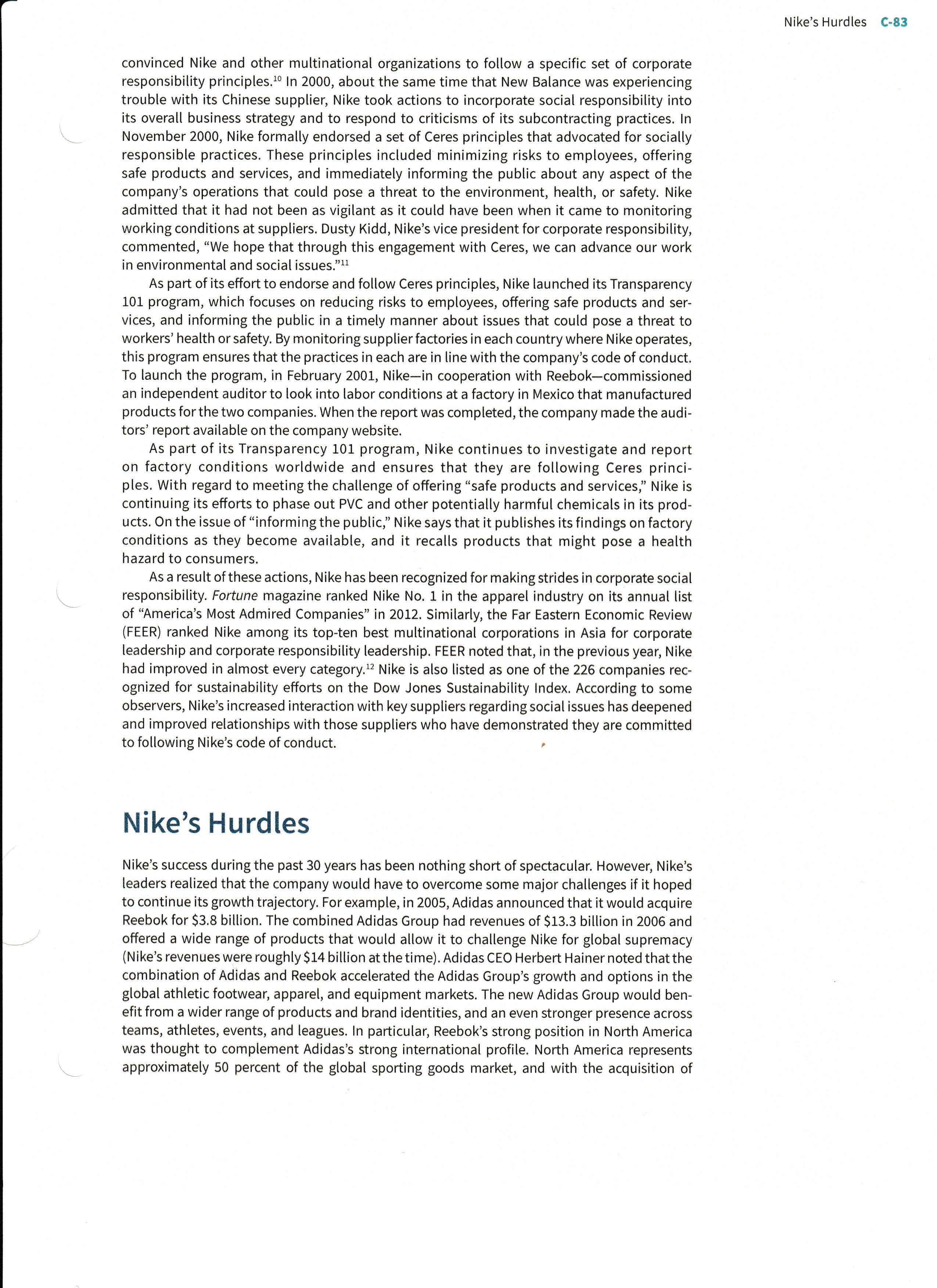
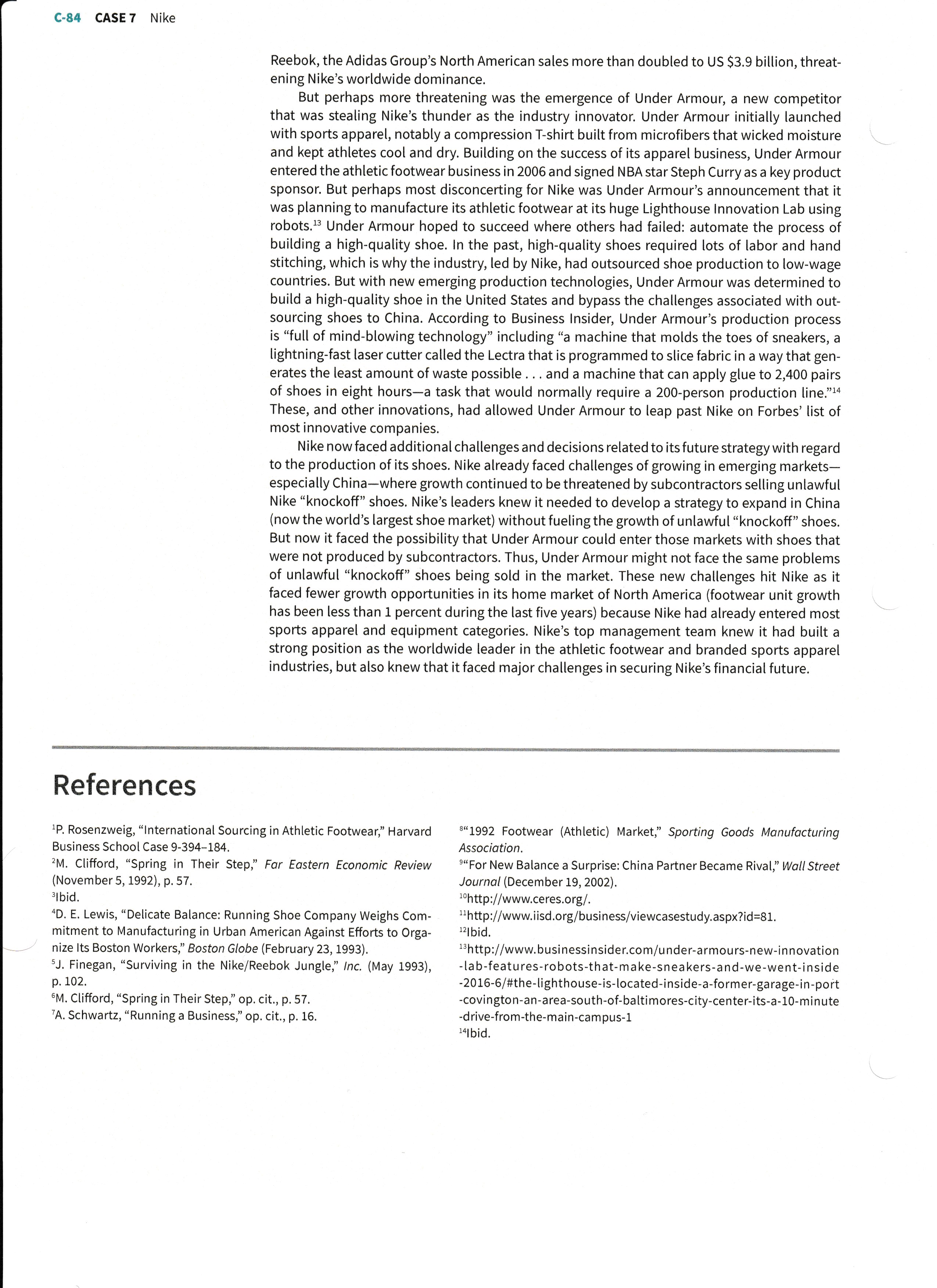 Sourcing and Strategy in Athletic Footwear Nike, Inc. is the world market share leader in athletic footwear, with 44 percent of the world market, compared to only 30 percent for Adidas/Reebok (see Exhibit 1). The Nike brand alone is valued at $10.7 billion-the most valuable brand among sports businesses. Many high-profile athletes and sports teams around the world are sponsored by Nike, with endorsers donning the highly recognized "swoosh" logo and the trademark "Just Do It." But Nike wasn't always the world leader. In fact, when Nike launched its first product in 1972, Adidas was the worldwide leader in athletic footwear sales, and Converse was the most recognized US athletic footwear brand. Adidas, the German shoe and sports apparel giant, was known for making high-performance shoes and held the dominant market share position. Adidas could not have imagined that, by 1992, Oregon-based upstart Nike would overtake it as the world's leading athletic footwear company. Moreover, Nike didn't just surpass Adidas in market share. It also consistently generated profitability ratios that were 50-100 percent higher than Adidas (see Exhibit 2 and Exhibit 3 for selected financial data). For example, in 2010, Nike's operating profits-to-sales ratio was 10.1 percent compared to 6.7 percent for Adidas. How did Nike, a small startup, leap past Adidas and Converse to emerge as the world leader in athletic footwear in just 20 years? What was unique about the company's strategy, and what lessons does the Nike story hold for other companies hoping to be the leaders in their industries? Finally, now that competitors, especially new ones such as Under Armour, understand Nike's path to leadership, how can Nike stay on top? EXHIBIT 1 Global Athletic Footwear Sales and Market Share by Major Brand (Estimated in millions of dollars at wholesale) *Reebok was purchased by Adidas in February 2006 Converse was purchased by Nike in July 2003 Source: Company annual reports; Privco. EXHIBIT2 Nike, Inc., Financial Performance, 2000-2016 (Year ended May 31; millions of dollars) *2005 Europe data also includes Middle Eastern and African sales *Total geo revenues will not add up to total revenues due to other sources of revenue that Nike has Source: Nike Annual Reports. EXHIBIT 3 Adidas Group Financial Performance, 1995-2016 (millions of euros) *In Euros, millions * 1995 results given in millions of Deutsche Marks Source: Adidas Annual Reports. Nike's Origins Nike was founded in 1962 as Blue Ribbon Sports by University of Oregon track athlete Phil Knight and his coach Bill Bowerman. The company initially operated as a distributor for Japanese shoe maker Onitsuka Tiger (now ASICS), making most of its sales at track meets, out of Knight's automobile. But the relationship between the two companies started to deteriorate in 1970, and Knight and Bowerman were ready to make the jump from being a footwear distributor to designing and manufacturing their own brand of athletic shoes. So, Bowerman and Knight designed their own track shoes and had them manufactured in low-cost Asian plants. Bowerman created a "waffle iron" design that improved traction while keeping the shoes extremely light. Bowerman and Knight selected a logo to put on the shoe, known internationally as the swoosh, which was created by a graphic design student, Carolyn Davidson, from Portland State University. Davidson was originally paid $35 for the logo design. (Knight later gave Davidson an undisclosed amount of Nike stock and a diamond ring with the swoosh engraved.) Then, in May 1971, Blue Ribbon changed its name to Nike after the Greek goddess of victory. The new Nike line of footwear debuted in 1972, just in time for the US Track and Field Trials in Eugene, Oregon. Early models of Nike's track shoes were primarily used by track athletes at the University of Oregon. Fortunately for Nike, one of those Oregon athletes was Steve Prefontaine, a middle- and long-distance runner who became a prominent track star. Prefontaine competed in the 1972 Olympics and once held the American record in seven different distance track events from the 2,000 meters to the 10,000 meters. Prefontaine's success catapulted Nike into the spotlight and jump-started the company's sales. Building on this momentum, Nike started to design shoes for other track stars and prominent athletes in other sports. The late 1970s and early 1980s saw sprinter Carl Lewis, marathon runner Joan Benoit, and tennis star John McEnroe sporting Nike shoes. The company hit the jackpot in the late 1980s when it signed basketball superstar Michael Jordan to an endorsement contract. Nike's Air Jordan sneakers, promoted by the player himself, were a huge winner in the basketball shoe segment of athletic footwear. The success of Air Jordan, and the entire Nike line, was helped by the "Just Do It" advertising campaign developed and launched by ad agency Wieden+Kennedy in 1988. The company hit the jackpot again in the late 1990s after signing golfing phenom Tiger Woods to an endorsement contract. Leveraging Woods's popularity, Nike not only entered the golf shoe market but also golf equipment and apparel. Even before Nike signed Woods, it was firmly ensconced as the leading athletic footwear company in the world. Nike's dramatic success in overtaking Adidas in such a short period of time was typically attributed to its successful and memorable marketing campaigns featuring well-known athletes. Although marketing has undoubtedly been critical to Nike's success, the company's ability to produce cutting-edge shoe designs that have attracted endorsers is sometimes overlooked. Nike made significant investments in shoe design, starting with running shoes and then branching out to tennis, basketball, soccer, golf, and other shoes for specific uses. Each year, Nike launched more than 100 new designs of different types of shoes. This practice stimulated new customer purchases by creating the desire to have the very best shoe possible to maximize performance. It also increased the overall size of the market as customers bought shoes for specific sports, often having as many as 5-10 different types of athletic footwear in their closets. Nike's decision to keep its focus on product design and marketing, and not manufacturing, is another little-understood factor that has influenced its success. The company chose not to produce any of its own shoes, preferring instead to hire independent suppliers in Asian countries such as South Korea, Taiwan, China, and Indonesia. These suppliers built high-quality shoes to exact specifications and delivered them according to precise delivery schedules. They helped Nike keep costs down because Asian labor was cheap and plentiful. This was in sharp contrast to the labor costs at many of the Adidas shoe-manufacturing facilities in Europe (mostly Germany) where labor costs were significantly higher. By outsourcing the production of its shoes to foreign suppliers, Nike was able to focus all of its attention and resources on shoe design and marketing. Nike's choices regarding which activities to conduct internally, and, thus, which activities to outsource to suppliers, played a critical role in propelling it to the top of its industry. Nike's Sourcing Practices Nike's use of Asian suppliers dates back to its humble beginning. The allure of low-cost labor in Asia was what initially attracted the attention of Phil Knight. An accountant by training, Knight had noticed the success of Japanese cameras in the 1950s against higher-priced German models, and he thought the same approach could work in the athletic footwear industry, where the leading brands (Adidas and Puma) were German. 1 Nike's advantage in athletic footwear came, in part, from creating cutting-edge designs that could be manufactured at low cost. Each year Nike's designers created more than 100 new shoe styles and colors. The company then sent designs to its Asian suppliers, which would develop and test prototypes. After these prototypes were approved, the blueprints were ready to be sent out to bid to suppliers. 2 Nike was known to constantly look for the supplier that could provide the lowest cost production for its shoes. According to Jeffrey Ballinger, an Asian-American Free Labor Institute (AAFLI) representative, Nike's strategy is to pit six factories against each other and have them compete for orders based on who produces the cheapest shoe. 3 An estimated cost breakdown of a 1995 Nike athletic shoe (the Pegasus running shoe) is presented in Exhibit 4. As seen in Exhibit 4, only about 15 percent of the cost of Nike shoe production was labor costs. This was significantly lower than the labor costs required to manufacture a shoe in Europe. In order to avoid dependence on a small number of suppliers, Nike cultivated working relationships with numerous manufacturers spanning a number of different countries. For example, large suppliers in China or Indonesia rarely produced for just one athletic shoe firm. A single plant might be producing Nike shoes in the same plant with Reebok or Converse production lines. Because of the low labor costs in Asia, by the mid-1990s, virtually all US athletic footwear companies relied on overseas manufacturing. There were a few exceptions, with one of the most notable being New Balance Athletic Shoe Inc., which operated four US plants and held a relatively small share of the US market. It focused on a niche market of customers interested in more-varied width sizing. Not surprisingly, employees at New Balance's US plants earned considerably more than their Asian counterparts. For example, hourly wages in US plants for apparel manufacturing averaged $8.16 compared to only $.25 in China and $.28 in Indonesia (See Exhibit 5 for a comparison of textile and apparel wages in selected markets for 1993 and 2007). In the Brighton, Massachusetts, plant, for instance, employees earned a base wage of $7.50 per hour, or between $8 and $12 per hour with benefits factored in. 4 With such high labor costs, New Balance was unable to profitably produce shoes that retailed for less than $50.5New Balance later moved the majority of its shoe production to Asia. Nike was well aware that production costs varied from country to country and could change over time as a result of changing labor costs and exchange rates. For example, in 1988, Nike purchased 66 percent of its shoes from suppliers located in South Korea. Wage rates grew rapidly in the 1980s and early 1990s in South Korean factories, with wages going from less than $1.00 Source: J. Ballinger and C. Olsson, Behind the Swoosh (Sweden: Global Publications Foundation, 1997). EXHIBIT 5 Hourly Labor Costs for Production Workers in the Textile and Apparel Industry-Selected Countries, 2007 *2011 data for Indonesia, South Korea, China, Taiwan, and the Philippines. 2012 textile data for the Philippines and Taiwan is the average manufacturing wage. Source: Bureau of Labor Statistics, OECD, Institute of Global Labour and Human Rights, ILO Department of Statistics, Werner International, Eurasia Group, Deloitte. per hour in 1980 to $3.66 by 1993 . The Korean Ministry of Labor reported that workers in shoe factories earned an average of $24.40 per day in 1990, compared to just $9.71 per day in 1986 . As a result, Nike's imports from South Korean suppliers dropped to 42 percent by 1992 and to less than 10 percent by the end of the 1990s, and employment in Pusan, South Korea's shoemanufacturing center, fell from nearly 500,000 in 1990 to 120,000 by 1993 . As wages increased, many Korean suppliers moved factories to lower-wage countries, such as Indonesia, so that they could be cost-competitive when bidding on contracts from Nike or other athletic footwear companies. Not only did changing wage rates influence the cost competitiveness of suppliers, but so did exchange rates. In the late 1990s, during the Asian financial crises, the costs to manufacture athletic footwear changed significantly from year to year, depending on a country's currency relative to the dollar. China, for example, pegged the RMB to the dollar to ensure a more stable currency. In contrast, Indonesia let its currency float, and within a two-year period, the exchange rate changed from roughly 4,000 rupiahs to the dollar to more than 10,000 rupiahs to the dollar. That allowed Nike to get more for its dollar by purchasing shoes and other materials from Indonesian suppliers than they could from suppliers in China. As a result, during the time period when the rupiah lost value to the dollar, Indonesian suppliers were more cost competitive and had a cost advantage when bidding for Nike shoe contracts. As a result of the changing wage and exchange rates, Nike had a truly global supplier network that it could draw upon for its shoe production. This allowed the company to shift production as necessary to plants in different countries that could provide the lowest-cost shoes at the moment. Nike was able to achieve this without building its own plants or making the investments necessary to develop a world-class manufacturing capability in shoes. Nike's practice of using a competitive bidding process was not without criticism, however. As suppliers worked to keep costs low and win the bids, some believed that Nike used exploitive labor practices and that the company should bear responsibility for the actions of its suppliers. In the 1990s, Nike executives often deflected these accusations, arguing that Nike did not own or operate its suppliers' factories. Neal Lauridsen, Nike's vice president for Asia, said, "We don't know the first thing about manufacturing. We are marketers and designers." And John Woodman, Nike's general manager in Jakarta at the time, further explained, "They are our subsuppliers. It's not within our scope to investigate [allegations of labor violations].7 Nike executives noted that the organization was a positive economic force within many emerging economies in Asia and provided thousands of jobs for people who probably wouldn't be working otherwise. Industry Changes Affecting Nike: 19942000 The market for branded athletic footwear continued to grow between 1994 and 2000, but at a slower rate. After nearly two decades of explosive growth, a slowdown was expected. By 1994, the average athletic shoe purchaser in the United States owned three pairs. 8 Faced with slowing US demand, Nike looked for new places and unique ways to grow. International sales were emphasized during this period, and Nike made steady inroads into European and Asian markets. The company also expanded into sports apparel and other footwear products, including hiking shoes and upscale men's shoes with the acquisition of Cole Haan. Nike continued to invest in product design, seeking lighter, more durable, and even more comfortable models. Competitors were never far behind. Reebok, for example, refined its Pump technology, which filled the shoe's upper with air, claiming it provided superior support and comfort. It also introduced GraphLite, which offered a graphite-composite structure in the arch that replaced part of the sole and reduced the weight of the shoe up to 10 percent. To further increase demand, Nike and Reebok, in particular, increased their investments in innovative product designs. Nike continued to rely on the endorsements of famous athletes, including Michael Jordan and Kobe Bryant, in its television campaigns. Reebok followed suit, signing endorsers such as Shaquille O'Neal, Allen Iverson, and Yao Ming. Competition began to heat up in the late 1990s as US growth slowed and Adidas shifted the bulk of its shoe production from Europe to Asia. Following Nike's lead, Adidas used the savings that resulted from lower-cost shoe production on marketing and high-profile endorsers. New Balance also increased its competitiveness by shifting roughly 70 percent of its shoe production to China. Both Adidas and New Balance increased their global shares of athletic footwear at this time, but Reebok's share fell. Nike was able to slowly grow its market share in athletic footwear during the late 1990s, but the overall growth in the US market dropped to half the rate of growth that took place in the 1980s. In 1999, Nike's sales dropped by 8 percent over its prior year's sales, highlighting the need for the company to look for even more innovative ways to grow. Nike's Quest for Growth Opportunities As growth in the athletic footwear market slowed in the late 1990s, Nike looked to extend its product lines into other sports equipment and apparel. Although Nike's core products had always been athletic shoes, the company decided to expand by manufacturing and selling equipment for golf, tennis, soccer, baseball, bicycling, volleyball, wrestling, and even auto racing. The company was very successful in developing and selling a line of golf apparel and equipment-notably golf balls and clubs-endorsed by Tiger Woods. In 2000, Nike signed Woods to a 5-year, \$105 million contract. It was the largest endorsing deal ever signed by an athlete at that time. Woods' endorsement has been credited with playing a significant role in helping the Nike Golf brand transform from a start-up golf company in the late 1990s to a leading golf apparel company in the world and a major player in the equipment and golf ball market, where it competes effectively with Titleist, Callaway, and Taylor Made. Nike looked for similar opportunities in other sports categories and started making equipment and apparel for many other sports. As it did with its shoes, Nike outsourced the manufacturing of its apparel and sports equipment to a variety of suppliers throughout the world. Indeed, using outside suppliers became even more important because of the wide variety of manufacturing that needed to be done for Nike-from shoes, to golf clubs, to volleyballs. Outsourcing production allowed Nike to move quickly into new product categories because it didn't have to acquire the knowledge about how to actually make the products that it designed and marketed. During the late 1990s and early 2000s, Nike was more aggressive about moving into apparel and other sports equipment than its major competitors, Adidas and Reebok, were. This helped Nike grow at a much faster rate than Adidas and Reebok. For example, Nike Golf was estimated to be generating roughly $600 million in sales by 2007 , while Adidas and Reebok generated insignificant sales from golf apparel and products. Nike's product category expansions during this time period also helped offset the slowing growth in sales of athletic footwear. Indeed, from 2000 to 2010 , Nike's sales grew from $9.0 billion to more than $19.0 billion. Outsourcing Challenges: New Balance's Experience Although Nike's experience with outsourcing was generally positive, such was not the case for all of its competitors. In early 2000, New Balance experienced a problem with a supplier that created concerns for all of the major makers of branded athletic footwear. Scores of deeply discounted New Balance shoes began showing up in stores from England to Australia. 9 One of New Balance's former Chinese suppliers, run by Taiwanese businessman Horace Chang, was continuing to produce and sell New Balance shoes. Chang had been a major supplier to New Balance, as well as a distributor of New Balance's shoes in China. However, New Balance and Chang had a falling out when the company vetoed Chang's proposed strategy for China-selling larger volumes of low priced shoes in China. The company felt that Chang's strategy would dilute its brand image. When New Balance shoes made by Chang's plants began appearing in cut-rate shops for as little as $20, it enraged New Balance's legitimate retailers, who were trying to sell the same shoes for as much as $60. Although attempting to compete directly with Reebok, Adidas, and Nike, New Balance was being relegated to the bargain bin. New Balance quickly sued Chang in the United States and did everything in its power to prevent "unlawful" New Balance shoes from being sold. With the help of China's State Administration of Industry and Commerce, Chang's warehouses were raided and more than 100,000 pairs of New Balance shoes were confiscated. Buoyed by signs of increased brand protection by Chinese authorities, New Balance filed a suit in Shenzen against Chang. However, in February of 2002, a Chinese judge ruled against New Balance. Instead of recognizing that New Balance had revoked its sales agreement with Chang, the judge cited an older document with Chang's manufacturing company, in which New Balance suggested that Chang's factory could manufacture the shoes until 2003. New Balance's painful experience caused Nike and other sports footwear and apparel companies to rethink their strategy of outsourcing products to suppliers from emerging economies. Each company reevaluated its sourcing strategy and began to think of ways to ensure that it did not experience the problems that New Balance did. Nike's Response to Industry Outsourcing Challenges During the 1990s, Nike frequently faced criticism for sourcing its shoes from Asian suppliers that had used questionable labor management practices. The concerns included unsafe working conditions, working laborers too many hours at low pay, and using child labor. Nike executives often deflected these accusations, arguing that Nike did not own or operate its suppliers' factories. But that started to change in 2000 when Ceres, a nonprofit organization advocating for sustainability leadership (including the rights of workers.and safe working conditions), convinced Nike and other multinational organizations to follow a specific set of corporate responsibility principles. 10 In 2000 , about the same time that New Balance was experiencing trouble with its Chinese supplier, Nike took actions to incorporate social responsibility into its overall business strategy and to respond to criticisms of its subcontracting practices. In November 2000, Nike formally endorsed a set of Ceres principles that advocated for socially responsible practices. These principles included minimizing risks to employees, offering safe products and services, and immediately informing the public about any aspect of the company's operations that could pose a threat to the environment, health, or safety. Nike admitted that it had not been as vigilant as it could have been when it came to monitoring working conditions at suppliers. Dusty Kidd, Nike's vice president for corporate responsibility, commented, "We hope that through this engagement with Ceres, we can advance our work in environmental and social issues." 11 As part of its effort to endorse and follow Ceres principles, Nike launched its Transparency 101 program, which focuses on reducing risks to employees, offering safe products and services, and informing the public in a timely manner about issues that could pose a threat to workers' health or safety. By monitoring supplier factories in each country where Nike operates, this program ensures that the practices in each are in line with the company's code of conduct. To launch the program, in February 2001, Nike-in cooperation with Reebok-commissioned an independent auditor to look into labor conditions at a factory in Mexico that manufactured products for the two companies. When the report was completed, the company made the auditors' report available on the company website. As part of its Transparency 101 program, Nike continues to investigate and report on factory conditions worldwide and ensures that they are following Ceres principles. With regard to meeting the challenge of offering "safe products and services," Nike is continuing its efforts to phase out PVC and other potentially harmful chemicals in its products. On the issue of "informing the public," Nike says that it publishes its findings on factory conditions as they become available, and it recalls products that might pose a health hazard to consumers. As a result of these actions, Nike has been recognized for making strides in corporate social responsibility. Fortune magazine ranked Nike No. 1 in the apparel industry on its annual list of "America's Most Admired Companies" in 2012. Similarly, the Far Eastern Economic Review (FEER) ranked Nike among its top-ten best multinational corporations in Asia for corporate leadership and corporate responsibility leadership. FEER noted that, in the previous year, Nike had improved in almost every category. 12 Nike is also listed as one of the 226 companies recognized for sustainability efforts on the Dow Jones Sustainability Index. According to some observers, Nike's increased interaction with key suppliers regarding social issues has deepened and improved relationships with those suppliers who have demonstrated they are committed to following Nike's code of conduct. Nike's Hurdles Nike's success during the past 30 years has been nothing short of spectacular. However, Nike's leaders realized that the company would have to overcome some major challenges if it hoped to continue its growth trajectory. For example, in 2005, Adidas announced that it would acquire Reebok for $3.8 billion. The combined Adidas Group had revenues of $13.3 billion in 2006 and offered a wide range of products that would allow it to challenge Nike for global supremacy (Nike's revenues were roughly $14 billion at the time). Adidas CEO Herbert Hainer noted that the combination of Adidas and Reebok accelerated the Adidas Group's growth and options in the global athletic footwear, apparel, and equipment markets. The new Adidas Group would benefit from a wider range of products and brand identities, and an even stronger presence across teams, athletes, events, and leagues. In particular, Reebok's strong position in North America was thought to complement Adidas's strong international profile. North America represents approximately 50 percent of the global sporting goods market, and with the acquisition of Reebok, the Adidas Group's North American sales more than doubled to US \$3.9 billion, threatening Nike's worldwide dominance. But perhaps more threatening was the emergence of Under Armour, a new competitor that was stealing Nike's thunder as the industry innovator. Under Armour initially launched with sports apparel, notably a compression T-shirt built from microfibers that wicked moisture and kept athletes cool and dry. Building on the success of its apparel business, Under Armour entered the athletic footwear business in 2006 and signed NBA star Steph Curry as a key product sponsor. But perhaps most disconcerting for Nike was Under Armour's announcement that it was planning to manufacture its athletic footwear at its huge Lighthouse Innovation Lab using robots. 13 Under Armour hoped to succeed where others had failed: automate the process of building a high-quality shoe. In the past, high-quality shoes required lots of labor and hand stitching, which is why the industry, led by Nike, had outsourced shoe production to low-wage countries. But with new emerging production technologies, Under Armour was determined to build a high-quality shoe in the United States and bypass the challenges associated with outsourcing shoes to China. According to Business Insider, Under Armour's production process is "full of mind-blowing technology" including "a machine that molds the toes of sneakers, a lightning-fast laser cutter called the Lectra that is programmed to slice fabric in a way that generates the least amount of waste possible ... and a machine that can apply glue to 2,400 pairs of shoes in eight hours-a task that would normally require a 200-person production line." 14 These, and other innovations, had allowed Under Armour to leap past Nike on Forbes' list of most innovative companies. Nike now faced additional challenges and decisions related to its future strategy with regard to the production of its shoes. Nike already faced challenges of growing in emerging marketsespecially China-where growth continued to be threatened by subcontractors selling unlawful Nike "knockoff" shoes. Nike's leaders knew it needed to develop a strategy to expand in China (now the world's largest shoe market) without fueling the growth of unlawful "knockoff" shoes. But now it faced the possibility that Under Armour could enter those markets with shoes that were not produced by subcontractors. Thus, Under Armour might not face the same problems of unlawful "knockoff" shoes being sold in the market. These new challenges hit Nike as it faced fewer growth opportunities in its home market of North America (footwear unit growth has been less than 1 percent during the last five years) because Nike had already entered most sports apparel and equipment categories. Nike's top management team knew it had built a strong position as the worldwide leader in the athletic footwear and branded sports apparel industries, but also knew that it faced major challenges in securing Nike's financial future. References 'P. Rosenzweig, "International Sourcing in Athletic Footwear," Harvard Business School Case 9-394-184. "M. Clifford, "Spring in Their Step," Far Eastern Economic Review (November 5, 1992), p. 57. 'Ibid. 4 D. E. Lewis, "Delicate Balance: Running Shoe Company Weighs Commitment to Manufacturing in Urban American Against Efforts to Organize Its Boston Workers," Boston Globe (February 23, 1993). "J. Finegan, "Surviving in the Nike/Reebok Jungle," Inc. (May 1993), p. 102. "M. Clifford, "Spring in Their Step," op. cit., p. 57. 'A. Schwartz, "Running a Business," op. cit., p. 16. 8"1992 Footwear (Athletic) Market," Sporting Goods Manufacturing Association. 9 "For New Balance a Surprise: China Partner Became Rival," Wall Street Journal (December 19, 2002). 10http:// www.ceres.org/. 11http// www.iisd.org/business/viewcasestudy.aspx?id=81. 12bid. 13http //www.businessinsider.com/under-armours-new-innovation -lab-features-robots-that-make-sneakers-and-we-went-inside -2016-6/\#the-lighthouse-is-located-inside-a-former-garage-in-port -covington-an-area-south-of-baltimores-city-center-its-a-10-minute -drive-from-the-main-campus-1 14 Ibid
Sourcing and Strategy in Athletic Footwear Nike, Inc. is the world market share leader in athletic footwear, with 44 percent of the world market, compared to only 30 percent for Adidas/Reebok (see Exhibit 1). The Nike brand alone is valued at $10.7 billion-the most valuable brand among sports businesses. Many high-profile athletes and sports teams around the world are sponsored by Nike, with endorsers donning the highly recognized "swoosh" logo and the trademark "Just Do It." But Nike wasn't always the world leader. In fact, when Nike launched its first product in 1972, Adidas was the worldwide leader in athletic footwear sales, and Converse was the most recognized US athletic footwear brand. Adidas, the German shoe and sports apparel giant, was known for making high-performance shoes and held the dominant market share position. Adidas could not have imagined that, by 1992, Oregon-based upstart Nike would overtake it as the world's leading athletic footwear company. Moreover, Nike didn't just surpass Adidas in market share. It also consistently generated profitability ratios that were 50-100 percent higher than Adidas (see Exhibit 2 and Exhibit 3 for selected financial data). For example, in 2010, Nike's operating profits-to-sales ratio was 10.1 percent compared to 6.7 percent for Adidas. How did Nike, a small startup, leap past Adidas and Converse to emerge as the world leader in athletic footwear in just 20 years? What was unique about the company's strategy, and what lessons does the Nike story hold for other companies hoping to be the leaders in their industries? Finally, now that competitors, especially new ones such as Under Armour, understand Nike's path to leadership, how can Nike stay on top? EXHIBIT 1 Global Athletic Footwear Sales and Market Share by Major Brand (Estimated in millions of dollars at wholesale) *Reebok was purchased by Adidas in February 2006 Converse was purchased by Nike in July 2003 Source: Company annual reports; Privco. EXHIBIT2 Nike, Inc., Financial Performance, 2000-2016 (Year ended May 31; millions of dollars) *2005 Europe data also includes Middle Eastern and African sales *Total geo revenues will not add up to total revenues due to other sources of revenue that Nike has Source: Nike Annual Reports. EXHIBIT 3 Adidas Group Financial Performance, 1995-2016 (millions of euros) *In Euros, millions * 1995 results given in millions of Deutsche Marks Source: Adidas Annual Reports. Nike's Origins Nike was founded in 1962 as Blue Ribbon Sports by University of Oregon track athlete Phil Knight and his coach Bill Bowerman. The company initially operated as a distributor for Japanese shoe maker Onitsuka Tiger (now ASICS), making most of its sales at track meets, out of Knight's automobile. But the relationship between the two companies started to deteriorate in 1970, and Knight and Bowerman were ready to make the jump from being a footwear distributor to designing and manufacturing their own brand of athletic shoes. So, Bowerman and Knight designed their own track shoes and had them manufactured in low-cost Asian plants. Bowerman created a "waffle iron" design that improved traction while keeping the shoes extremely light. Bowerman and Knight selected a logo to put on the shoe, known internationally as the swoosh, which was created by a graphic design student, Carolyn Davidson, from Portland State University. Davidson was originally paid $35 for the logo design. (Knight later gave Davidson an undisclosed amount of Nike stock and a diamond ring with the swoosh engraved.) Then, in May 1971, Blue Ribbon changed its name to Nike after the Greek goddess of victory. The new Nike line of footwear debuted in 1972, just in time for the US Track and Field Trials in Eugene, Oregon. Early models of Nike's track shoes were primarily used by track athletes at the University of Oregon. Fortunately for Nike, one of those Oregon athletes was Steve Prefontaine, a middle- and long-distance runner who became a prominent track star. Prefontaine competed in the 1972 Olympics and once held the American record in seven different distance track events from the 2,000 meters to the 10,000 meters. Prefontaine's success catapulted Nike into the spotlight and jump-started the company's sales. Building on this momentum, Nike started to design shoes for other track stars and prominent athletes in other sports. The late 1970s and early 1980s saw sprinter Carl Lewis, marathon runner Joan Benoit, and tennis star John McEnroe sporting Nike shoes. The company hit the jackpot in the late 1980s when it signed basketball superstar Michael Jordan to an endorsement contract. Nike's Air Jordan sneakers, promoted by the player himself, were a huge winner in the basketball shoe segment of athletic footwear. The success of Air Jordan, and the entire Nike line, was helped by the "Just Do It" advertising campaign developed and launched by ad agency Wieden+Kennedy in 1988. The company hit the jackpot again in the late 1990s after signing golfing phenom Tiger Woods to an endorsement contract. Leveraging Woods's popularity, Nike not only entered the golf shoe market but also golf equipment and apparel. Even before Nike signed Woods, it was firmly ensconced as the leading athletic footwear company in the world. Nike's dramatic success in overtaking Adidas in such a short period of time was typically attributed to its successful and memorable marketing campaigns featuring well-known athletes. Although marketing has undoubtedly been critical to Nike's success, the company's ability to produce cutting-edge shoe designs that have attracted endorsers is sometimes overlooked. Nike made significant investments in shoe design, starting with running shoes and then branching out to tennis, basketball, soccer, golf, and other shoes for specific uses. Each year, Nike launched more than 100 new designs of different types of shoes. This practice stimulated new customer purchases by creating the desire to have the very best shoe possible to maximize performance. It also increased the overall size of the market as customers bought shoes for specific sports, often having as many as 5-10 different types of athletic footwear in their closets. Nike's decision to keep its focus on product design and marketing, and not manufacturing, is another little-understood factor that has influenced its success. The company chose not to produce any of its own shoes, preferring instead to hire independent suppliers in Asian countries such as South Korea, Taiwan, China, and Indonesia. These suppliers built high-quality shoes to exact specifications and delivered them according to precise delivery schedules. They helped Nike keep costs down because Asian labor was cheap and plentiful. This was in sharp contrast to the labor costs at many of the Adidas shoe-manufacturing facilities in Europe (mostly Germany) where labor costs were significantly higher. By outsourcing the production of its shoes to foreign suppliers, Nike was able to focus all of its attention and resources on shoe design and marketing. Nike's choices regarding which activities to conduct internally, and, thus, which activities to outsource to suppliers, played a critical role in propelling it to the top of its industry. Nike's Sourcing Practices Nike's use of Asian suppliers dates back to its humble beginning. The allure of low-cost labor in Asia was what initially attracted the attention of Phil Knight. An accountant by training, Knight had noticed the success of Japanese cameras in the 1950s against higher-priced German models, and he thought the same approach could work in the athletic footwear industry, where the leading brands (Adidas and Puma) were German. 1 Nike's advantage in athletic footwear came, in part, from creating cutting-edge designs that could be manufactured at low cost. Each year Nike's designers created more than 100 new shoe styles and colors. The company then sent designs to its Asian suppliers, which would develop and test prototypes. After these prototypes were approved, the blueprints were ready to be sent out to bid to suppliers. 2 Nike was known to constantly look for the supplier that could provide the lowest cost production for its shoes. According to Jeffrey Ballinger, an Asian-American Free Labor Institute (AAFLI) representative, Nike's strategy is to pit six factories against each other and have them compete for orders based on who produces the cheapest shoe. 3 An estimated cost breakdown of a 1995 Nike athletic shoe (the Pegasus running shoe) is presented in Exhibit 4. As seen in Exhibit 4, only about 15 percent of the cost of Nike shoe production was labor costs. This was significantly lower than the labor costs required to manufacture a shoe in Europe. In order to avoid dependence on a small number of suppliers, Nike cultivated working relationships with numerous manufacturers spanning a number of different countries. For example, large suppliers in China or Indonesia rarely produced for just one athletic shoe firm. A single plant might be producing Nike shoes in the same plant with Reebok or Converse production lines. Because of the low labor costs in Asia, by the mid-1990s, virtually all US athletic footwear companies relied on overseas manufacturing. There were a few exceptions, with one of the most notable being New Balance Athletic Shoe Inc., which operated four US plants and held a relatively small share of the US market. It focused on a niche market of customers interested in more-varied width sizing. Not surprisingly, employees at New Balance's US plants earned considerably more than their Asian counterparts. For example, hourly wages in US plants for apparel manufacturing averaged $8.16 compared to only $.25 in China and $.28 in Indonesia (See Exhibit 5 for a comparison of textile and apparel wages in selected markets for 1993 and 2007). In the Brighton, Massachusetts, plant, for instance, employees earned a base wage of $7.50 per hour, or between $8 and $12 per hour with benefits factored in. 4 With such high labor costs, New Balance was unable to profitably produce shoes that retailed for less than $50.5New Balance later moved the majority of its shoe production to Asia. Nike was well aware that production costs varied from country to country and could change over time as a result of changing labor costs and exchange rates. For example, in 1988, Nike purchased 66 percent of its shoes from suppliers located in South Korea. Wage rates grew rapidly in the 1980s and early 1990s in South Korean factories, with wages going from less than $1.00 Source: J. Ballinger and C. Olsson, Behind the Swoosh (Sweden: Global Publications Foundation, 1997). EXHIBIT 5 Hourly Labor Costs for Production Workers in the Textile and Apparel Industry-Selected Countries, 2007 *2011 data for Indonesia, South Korea, China, Taiwan, and the Philippines. 2012 textile data for the Philippines and Taiwan is the average manufacturing wage. Source: Bureau of Labor Statistics, OECD, Institute of Global Labour and Human Rights, ILO Department of Statistics, Werner International, Eurasia Group, Deloitte. per hour in 1980 to $3.66 by 1993 . The Korean Ministry of Labor reported that workers in shoe factories earned an average of $24.40 per day in 1990, compared to just $9.71 per day in 1986 . As a result, Nike's imports from South Korean suppliers dropped to 42 percent by 1992 and to less than 10 percent by the end of the 1990s, and employment in Pusan, South Korea's shoemanufacturing center, fell from nearly 500,000 in 1990 to 120,000 by 1993 . As wages increased, many Korean suppliers moved factories to lower-wage countries, such as Indonesia, so that they could be cost-competitive when bidding on contracts from Nike or other athletic footwear companies. Not only did changing wage rates influence the cost competitiveness of suppliers, but so did exchange rates. In the late 1990s, during the Asian financial crises, the costs to manufacture athletic footwear changed significantly from year to year, depending on a country's currency relative to the dollar. China, for example, pegged the RMB to the dollar to ensure a more stable currency. In contrast, Indonesia let its currency float, and within a two-year period, the exchange rate changed from roughly 4,000 rupiahs to the dollar to more than 10,000 rupiahs to the dollar. That allowed Nike to get more for its dollar by purchasing shoes and other materials from Indonesian suppliers than they could from suppliers in China. As a result, during the time period when the rupiah lost value to the dollar, Indonesian suppliers were more cost competitive and had a cost advantage when bidding for Nike shoe contracts. As a result of the changing wage and exchange rates, Nike had a truly global supplier network that it could draw upon for its shoe production. This allowed the company to shift production as necessary to plants in different countries that could provide the lowest-cost shoes at the moment. Nike was able to achieve this without building its own plants or making the investments necessary to develop a world-class manufacturing capability in shoes. Nike's practice of using a competitive bidding process was not without criticism, however. As suppliers worked to keep costs low and win the bids, some believed that Nike used exploitive labor practices and that the company should bear responsibility for the actions of its suppliers. In the 1990s, Nike executives often deflected these accusations, arguing that Nike did not own or operate its suppliers' factories. Neal Lauridsen, Nike's vice president for Asia, said, "We don't know the first thing about manufacturing. We are marketers and designers." And John Woodman, Nike's general manager in Jakarta at the time, further explained, "They are our subsuppliers. It's not within our scope to investigate [allegations of labor violations].7 Nike executives noted that the organization was a positive economic force within many emerging economies in Asia and provided thousands of jobs for people who probably wouldn't be working otherwise. Industry Changes Affecting Nike: 19942000 The market for branded athletic footwear continued to grow between 1994 and 2000, but at a slower rate. After nearly two decades of explosive growth, a slowdown was expected. By 1994, the average athletic shoe purchaser in the United States owned three pairs. 8 Faced with slowing US demand, Nike looked for new places and unique ways to grow. International sales were emphasized during this period, and Nike made steady inroads into European and Asian markets. The company also expanded into sports apparel and other footwear products, including hiking shoes and upscale men's shoes with the acquisition of Cole Haan. Nike continued to invest in product design, seeking lighter, more durable, and even more comfortable models. Competitors were never far behind. Reebok, for example, refined its Pump technology, which filled the shoe's upper with air, claiming it provided superior support and comfort. It also introduced GraphLite, which offered a graphite-composite structure in the arch that replaced part of the sole and reduced the weight of the shoe up to 10 percent. To further increase demand, Nike and Reebok, in particular, increased their investments in innovative product designs. Nike continued to rely on the endorsements of famous athletes, including Michael Jordan and Kobe Bryant, in its television campaigns. Reebok followed suit, signing endorsers such as Shaquille O'Neal, Allen Iverson, and Yao Ming. Competition began to heat up in the late 1990s as US growth slowed and Adidas shifted the bulk of its shoe production from Europe to Asia. Following Nike's lead, Adidas used the savings that resulted from lower-cost shoe production on marketing and high-profile endorsers. New Balance also increased its competitiveness by shifting roughly 70 percent of its shoe production to China. Both Adidas and New Balance increased their global shares of athletic footwear at this time, but Reebok's share fell. Nike was able to slowly grow its market share in athletic footwear during the late 1990s, but the overall growth in the US market dropped to half the rate of growth that took place in the 1980s. In 1999, Nike's sales dropped by 8 percent over its prior year's sales, highlighting the need for the company to look for even more innovative ways to grow. Nike's Quest for Growth Opportunities As growth in the athletic footwear market slowed in the late 1990s, Nike looked to extend its product lines into other sports equipment and apparel. Although Nike's core products had always been athletic shoes, the company decided to expand by manufacturing and selling equipment for golf, tennis, soccer, baseball, bicycling, volleyball, wrestling, and even auto racing. The company was very successful in developing and selling a line of golf apparel and equipment-notably golf balls and clubs-endorsed by Tiger Woods. In 2000, Nike signed Woods to a 5-year, \$105 million contract. It was the largest endorsing deal ever signed by an athlete at that time. Woods' endorsement has been credited with playing a significant role in helping the Nike Golf brand transform from a start-up golf company in the late 1990s to a leading golf apparel company in the world and a major player in the equipment and golf ball market, where it competes effectively with Titleist, Callaway, and Taylor Made. Nike looked for similar opportunities in other sports categories and started making equipment and apparel for many other sports. As it did with its shoes, Nike outsourced the manufacturing of its apparel and sports equipment to a variety of suppliers throughout the world. Indeed, using outside suppliers became even more important because of the wide variety of manufacturing that needed to be done for Nike-from shoes, to golf clubs, to volleyballs. Outsourcing production allowed Nike to move quickly into new product categories because it didn't have to acquire the knowledge about how to actually make the products that it designed and marketed. During the late 1990s and early 2000s, Nike was more aggressive about moving into apparel and other sports equipment than its major competitors, Adidas and Reebok, were. This helped Nike grow at a much faster rate than Adidas and Reebok. For example, Nike Golf was estimated to be generating roughly $600 million in sales by 2007 , while Adidas and Reebok generated insignificant sales from golf apparel and products. Nike's product category expansions during this time period also helped offset the slowing growth in sales of athletic footwear. Indeed, from 2000 to 2010 , Nike's sales grew from $9.0 billion to more than $19.0 billion. Outsourcing Challenges: New Balance's Experience Although Nike's experience with outsourcing was generally positive, such was not the case for all of its competitors. In early 2000, New Balance experienced a problem with a supplier that created concerns for all of the major makers of branded athletic footwear. Scores of deeply discounted New Balance shoes began showing up in stores from England to Australia. 9 One of New Balance's former Chinese suppliers, run by Taiwanese businessman Horace Chang, was continuing to produce and sell New Balance shoes. Chang had been a major supplier to New Balance, as well as a distributor of New Balance's shoes in China. However, New Balance and Chang had a falling out when the company vetoed Chang's proposed strategy for China-selling larger volumes of low priced shoes in China. The company felt that Chang's strategy would dilute its brand image. When New Balance shoes made by Chang's plants began appearing in cut-rate shops for as little as $20, it enraged New Balance's legitimate retailers, who were trying to sell the same shoes for as much as $60. Although attempting to compete directly with Reebok, Adidas, and Nike, New Balance was being relegated to the bargain bin. New Balance quickly sued Chang in the United States and did everything in its power to prevent "unlawful" New Balance shoes from being sold. With the help of China's State Administration of Industry and Commerce, Chang's warehouses were raided and more than 100,000 pairs of New Balance shoes were confiscated. Buoyed by signs of increased brand protection by Chinese authorities, New Balance filed a suit in Shenzen against Chang. However, in February of 2002, a Chinese judge ruled against New Balance. Instead of recognizing that New Balance had revoked its sales agreement with Chang, the judge cited an older document with Chang's manufacturing company, in which New Balance suggested that Chang's factory could manufacture the shoes until 2003. New Balance's painful experience caused Nike and other sports footwear and apparel companies to rethink their strategy of outsourcing products to suppliers from emerging economies. Each company reevaluated its sourcing strategy and began to think of ways to ensure that it did not experience the problems that New Balance did. Nike's Response to Industry Outsourcing Challenges During the 1990s, Nike frequently faced criticism for sourcing its shoes from Asian suppliers that had used questionable labor management practices. The concerns included unsafe working conditions, working laborers too many hours at low pay, and using child labor. Nike executives often deflected these accusations, arguing that Nike did not own or operate its suppliers' factories. But that started to change in 2000 when Ceres, a nonprofit organization advocating for sustainability leadership (including the rights of workers.and safe working conditions), convinced Nike and other multinational organizations to follow a specific set of corporate responsibility principles. 10 In 2000 , about the same time that New Balance was experiencing trouble with its Chinese supplier, Nike took actions to incorporate social responsibility into its overall business strategy and to respond to criticisms of its subcontracting practices. In November 2000, Nike formally endorsed a set of Ceres principles that advocated for socially responsible practices. These principles included minimizing risks to employees, offering safe products and services, and immediately informing the public about any aspect of the company's operations that could pose a threat to the environment, health, or safety. Nike admitted that it had not been as vigilant as it could have been when it came to monitoring working conditions at suppliers. Dusty Kidd, Nike's vice president for corporate responsibility, commented, "We hope that through this engagement with Ceres, we can advance our work in environmental and social issues." 11 As part of its effort to endorse and follow Ceres principles, Nike launched its Transparency 101 program, which focuses on reducing risks to employees, offering safe products and services, and informing the public in a timely manner about issues that could pose a threat to workers' health or safety. By monitoring supplier factories in each country where Nike operates, this program ensures that the practices in each are in line with the company's code of conduct. To launch the program, in February 2001, Nike-in cooperation with Reebok-commissioned an independent auditor to look into labor conditions at a factory in Mexico that manufactured products for the two companies. When the report was completed, the company made the auditors' report available on the company website. As part of its Transparency 101 program, Nike continues to investigate and report on factory conditions worldwide and ensures that they are following Ceres principles. With regard to meeting the challenge of offering "safe products and services," Nike is continuing its efforts to phase out PVC and other potentially harmful chemicals in its products. On the issue of "informing the public," Nike says that it publishes its findings on factory conditions as they become available, and it recalls products that might pose a health hazard to consumers. As a result of these actions, Nike has been recognized for making strides in corporate social responsibility. Fortune magazine ranked Nike No. 1 in the apparel industry on its annual list of "America's Most Admired Companies" in 2012. Similarly, the Far Eastern Economic Review (FEER) ranked Nike among its top-ten best multinational corporations in Asia for corporate leadership and corporate responsibility leadership. FEER noted that, in the previous year, Nike had improved in almost every category. 12 Nike is also listed as one of the 226 companies recognized for sustainability efforts on the Dow Jones Sustainability Index. According to some observers, Nike's increased interaction with key suppliers regarding social issues has deepened and improved relationships with those suppliers who have demonstrated they are committed to following Nike's code of conduct. Nike's Hurdles Nike's success during the past 30 years has been nothing short of spectacular. However, Nike's leaders realized that the company would have to overcome some major challenges if it hoped to continue its growth trajectory. For example, in 2005, Adidas announced that it would acquire Reebok for $3.8 billion. The combined Adidas Group had revenues of $13.3 billion in 2006 and offered a wide range of products that would allow it to challenge Nike for global supremacy (Nike's revenues were roughly $14 billion at the time). Adidas CEO Herbert Hainer noted that the combination of Adidas and Reebok accelerated the Adidas Group's growth and options in the global athletic footwear, apparel, and equipment markets. The new Adidas Group would benefit from a wider range of products and brand identities, and an even stronger presence across teams, athletes, events, and leagues. In particular, Reebok's strong position in North America was thought to complement Adidas's strong international profile. North America represents approximately 50 percent of the global sporting goods market, and with the acquisition of Reebok, the Adidas Group's North American sales more than doubled to US \$3.9 billion, threatening Nike's worldwide dominance. But perhaps more threatening was the emergence of Under Armour, a new competitor that was stealing Nike's thunder as the industry innovator. Under Armour initially launched with sports apparel, notably a compression T-shirt built from microfibers that wicked moisture and kept athletes cool and dry. Building on the success of its apparel business, Under Armour entered the athletic footwear business in 2006 and signed NBA star Steph Curry as a key product sponsor. But perhaps most disconcerting for Nike was Under Armour's announcement that it was planning to manufacture its athletic footwear at its huge Lighthouse Innovation Lab using robots. 13 Under Armour hoped to succeed where others had failed: automate the process of building a high-quality shoe. In the past, high-quality shoes required lots of labor and hand stitching, which is why the industry, led by Nike, had outsourced shoe production to low-wage countries. But with new emerging production technologies, Under Armour was determined to build a high-quality shoe in the United States and bypass the challenges associated with outsourcing shoes to China. According to Business Insider, Under Armour's production process is "full of mind-blowing technology" including "a machine that molds the toes of sneakers, a lightning-fast laser cutter called the Lectra that is programmed to slice fabric in a way that generates the least amount of waste possible ... and a machine that can apply glue to 2,400 pairs of shoes in eight hours-a task that would normally require a 200-person production line." 14 These, and other innovations, had allowed Under Armour to leap past Nike on Forbes' list of most innovative companies. Nike now faced additional challenges and decisions related to its future strategy with regard to the production of its shoes. Nike already faced challenges of growing in emerging marketsespecially China-where growth continued to be threatened by subcontractors selling unlawful Nike "knockoff" shoes. Nike's leaders knew it needed to develop a strategy to expand in China (now the world's largest shoe market) without fueling the growth of unlawful "knockoff" shoes. But now it faced the possibility that Under Armour could enter those markets with shoes that were not produced by subcontractors. Thus, Under Armour might not face the same problems of unlawful "knockoff" shoes being sold in the market. These new challenges hit Nike as it faced fewer growth opportunities in its home market of North America (footwear unit growth has been less than 1 percent during the last five years) because Nike had already entered most sports apparel and equipment categories. Nike's top management team knew it had built a strong position as the worldwide leader in the athletic footwear and branded sports apparel industries, but also knew that it faced major challenges in securing Nike's financial future. References 'P. Rosenzweig, "International Sourcing in Athletic Footwear," Harvard Business School Case 9-394-184. "M. Clifford, "Spring in Their Step," Far Eastern Economic Review (November 5, 1992), p. 57. 'Ibid. 4 D. E. Lewis, "Delicate Balance: Running Shoe Company Weighs Commitment to Manufacturing in Urban American Against Efforts to Organize Its Boston Workers," Boston Globe (February 23, 1993). "J. Finegan, "Surviving in the Nike/Reebok Jungle," Inc. (May 1993), p. 102. "M. Clifford, "Spring in Their Step," op. cit., p. 57. 'A. Schwartz, "Running a Business," op. cit., p. 16. 8"1992 Footwear (Athletic) Market," Sporting Goods Manufacturing Association. 9 "For New Balance a Surprise: China Partner Became Rival," Wall Street Journal (December 19, 2002). 10http:// www.ceres.org/. 11http// www.iisd.org/business/viewcasestudy.aspx?id=81. 12bid. 13http //www.businessinsider.com/under-armours-new-innovation -lab-features-robots-that-make-sneakers-and-we-went-inside -2016-6/\#the-lighthouse-is-located-inside-a-former-garage-in-port -covington-an-area-south-of-baltimores-city-center-its-a-10-minute -drive-from-the-main-campus-1 14 Ibid Step by Step Solution
There are 3 Steps involved in it
Step: 1

Get Instant Access to Expert-Tailored Solutions
See step-by-step solutions with expert insights and AI powered tools for academic success
Step: 2

Step: 3

Ace Your Homework with AI
Get the answers you need in no time with our AI-driven, step-by-step assistance
Get Started


